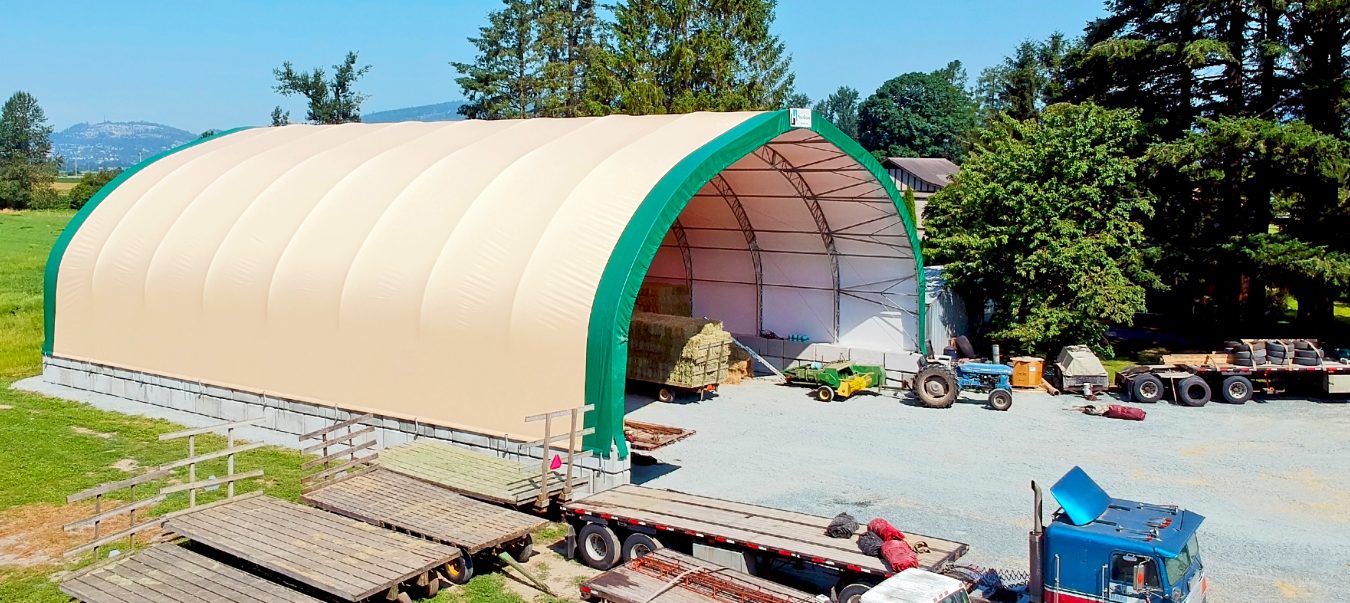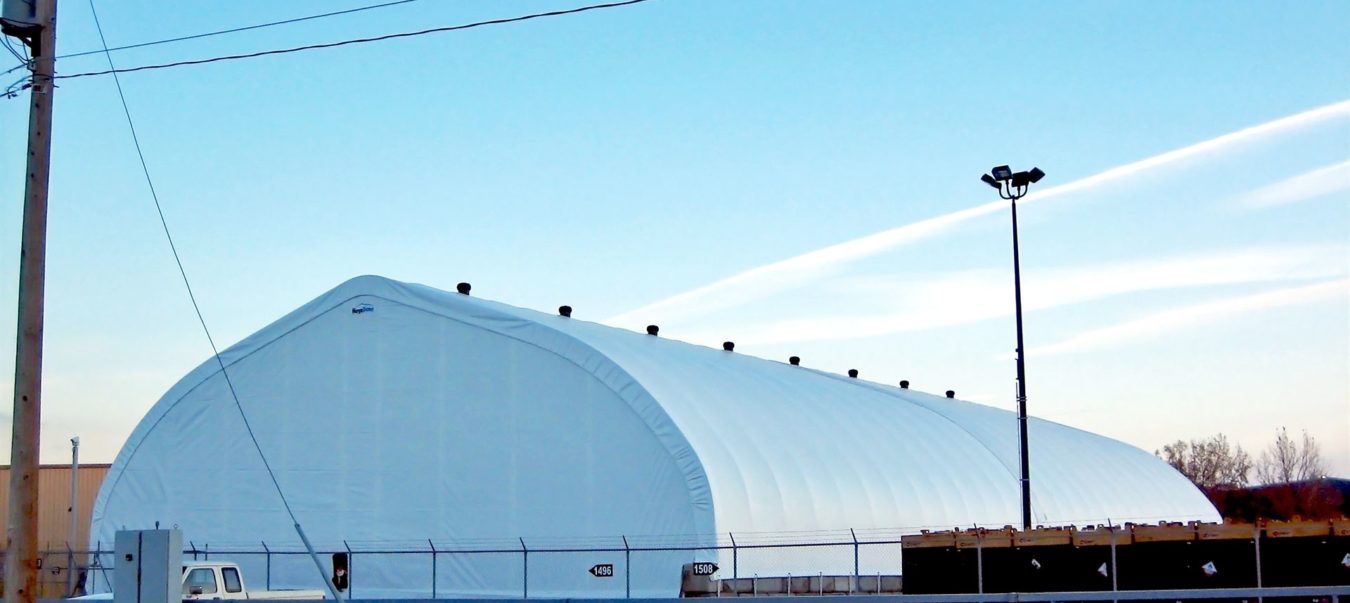Every business needs space, but how much and how it’s used depends on the work they do. For some, it’s about housing essential equipment or storing bulk materials; for others, it’s about providing comfortable shelter for livestock. However, one thing that all businesses have in common, regardless of industry, is the desire to strike a balance between functionality and long-term value.
For decades, traditional brick or steel construction was the standard for building needs. Today, more industries are turning to pre-engineered fabric structures, which provide greater flexibility, efficiency, and cost savings. They’re quick to install, easier to maintain, and engineered to meet Canadian building codes, making them a long-term solution that performs as well as traditional construction in all climates and applications.
With that said, let’s take a look at four industries where canvas buildings are making a difference.
Agriculture: Protecting Livestock and Equipment

Farmers have long faced the challenges of protecting their animals, equipment, and crops from unpredictable and unforgiving weather conditions. Traditionally, they relied on wood or metal barns to provide shelter from the elements, but these structures are becoming more expensive, take longer to build, and are less adaptable.
Fabric covered buildings offer a more versatile alternative for housing and protecting everything from livestock barns to hay and equipment storage. Clear-span design means no interior columns, providing farmers with wide, open spaces that can easily be reconfigured or expanded to accommodate changing needs.
Modern fabric structures also create healthier living environments for animals. Cattle and horses, for instance, thrive in natural light, which can’t be fully replicated by artificial bulbs. The fabric covering filters UV rays while still allowing sunlight to pass through, which reduces stress on animals, helps regulate their natural rhythms, and improves their overall well-being.
Mining and Energy: Durable Structures for Remote Sites

Mining and energy projects generally operate in remote areas, where access is challenging and weather conditions are unpredictable. In this environment, having reliable infrastructure to house workers, equipment, and essential supplies is crucial. Conventional construction is often unrealistic in these hard-to-reach places, and those in the mining industry often rely on prefabricated steel structures or modular camps for shelter and storage. However, pre-engineered fabric buildings are proving to be a stronger alternative.
These structures are designed to handle extreme weather conditions, from heavy snow to high winds, while offering the speed and flexibility that remote projects demand. And unlike steel buildings, which require heavy foundations and lengthy construction schedules, canvas buildings can be installed quickly on a variety of foundations, so projects can get up and running faster. What’s more, if locations change or projects wind down, the buildings can also be relocated.
The clear-span interior design easily provides enough room for machinery or bulk storage. At the same time, the natural light that filters through the fabric cover reduces the need for constant artificial lighting. In terms of cost, comfort, and flexibility, pre-engineered fabric buildings offer more value and better long-term performance than comparable alternatives.
Manufacturing: Space That Works as Hard as You Do
The key to running a successful manufacturing facility isn’t just a matter of square footage; it’s about how functional that space is and how it can be utilized to support workflows. The manufacturing industry moves fast, and businesses often need the ability to scale quickly to capitalize on new opportunities. Whether it’s setting up assembly lines, storing raw materials, or keeping finished products ready for shipment, having the right infrastructure can make or break productivity. The challenge is that traditional buildings can’t always keep pace with changing operations.
Fabric buildings give manufacturers a faster, more flexible alternative. Where a traditional facility can take years to go from concept to completion, an engineered fabric building can be up and running in weeks. And with clear-span interiors, you get wide-open floor space that can be configured (and reconfigured) around machinery, shelving, or logistics operations without columns getting in the way.
In terms of cost, pre-engineered fabric buildings are hard to beat. Upfront costs are a fraction of traditional alternatives, and ongoing maintenance requirements are minimal. The natural light filtering through the fabric and ventilation help reduce energy use while also creating a brighter, more comfortable workspace.
Municipal and Public Works: Durable, Low-Maintenance Solutions
As communities grow, cities and municipalities face constant pressure to maintain smooth operations, often on extremely tight budgets. One of the biggest challenges? Finding storage facilities that can accommodate quickly shifting needs and require minimal upkeep. For many, fabric buildings offer an ideal solution, combining durability, flexibility, and cost efficiency in one package.
With corrosion-resistant materials, clear-span interiors, and fast installation, these structures can store everything from salt and sand to vehicle fleets and heavy equipment. Coastal areas use them to protect cargo and machinery from harsh salt air, while inland communities rely on them for snow removal equipment, buses, and seasonal maintenance supplies.
Because these fabric buildings can last decades with minimal maintenance, municipalities are free to focus their resources elsewhere. What’s even more appealing is that building versatility means a single structure can adapt to multiple uses over time, providing a long-term solution for public infrastructure.
The Bottom Line: One Building, Endless Possibilities
The possibilities for pre-engineered fabric buildings are virtually limitless. Whether you’re managing a farm, running a mining operation, ramping up manufacturing capacity, or supporting municipal services, fabric structures offer speed, durability, and adaptability that traditional construction can’t match. With lower costs, faster installation, and reliable performance, fabric buildings aren’t just a temporary solution; they’re a long-term investment that can grow with your needs.
Contact BuildWorks today to explore how a pre-engineered fabric building can streamline your operations, save on costs, and provide a long-term solution for your industrial or commercial needs.
Also Read:
Why Pre-Engineered Fabric Buildings Outperform Traditional Construction
The Regulations and Permits Behind Coverall Fabric Buildings
Please complete this form to receive a
your FREE Design Guide.
Please fill out the form below to request to quote.